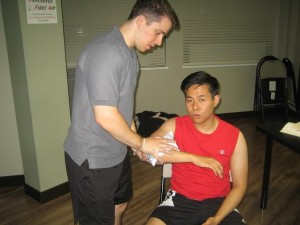Golfer’s elbow is a form of tendinitis that is very similar to a tennis elbow injury, or lateral epicondylitis, as both have the same presenting symptom of elbow pain. The main difference lies at the location of the pain as people with golfer’s elbow complain of pain at the medial or inside aspect of the elbow instead of pain at the lateral or outer side. This pain is thought to be brought about by the inflammation from a tear in the tendon of the forearm muscles near its attachment to the bony prominence at the inside part of the elbow, or the medial epicondyle. The overuse of the muscles in the forearm or the repetitive bending at the elbow forces the tendon to rub against the bone, which eventually leads to the wear and tear of the tendon. Thus, it is often seen in golfers and other sports that involve prolonged periods of repetitive wrist extension and forearm rotation such as tennis, bowling and baseball. Other activities that make use of the same range of motion, such as chopping wood, painting and raking, are also at risk of developing this injury
Although very similar to tennis elbow, a golfer’s elbow injury is much less common. In fact, in the United State of America, only 10 to 20% of all cases of epicondylitis are diagnosed as golfer’s elbow. This injury almost always occurs in the person’s dominant hand but can also be present at the non-dominant hand.
Signs and Symptoms of Golfer’s Elbow
Being an overuse injury, the signs and symptoms of a golfer’s elbow often develop gradually. Golfer’s elbow should be suspected if the following are present:
- Worsening pain, tenderness and swelling at the inside of the elbow, usually around the area of the bony prominence
- Pain that may spread to the forearm and wrist
- Difficulty in gripping objects
- Feeling of stiffness or numbness of the elbow
Treatment of Golfer’s Elbow
Treatment of golfer’s elbow may vary depending on how long the injury has persisted. For an acute injury, or an injury less than 4 weeks old, the following may be done:

- Apply ice compress multiple times a day for around 10 minutes each time
- Rest the elbow by avoiding any activities that may aggravate the injury such as going back to your sport right away or performing workouts that involve a lot of gripping
- Taking Non-steroidal Anti-inflammatory medications such as ibuprofen and aspirin to reduce the swelling and inflammation
For a chronic injury that persists for several months, the following may be done:
- Physical therapy or occupational therapy such as massages, strengthening exercises and stretching to hasten and improve muscle recovery
- Corticosteroid injections such as cortisone
- Open or arthroscopic surgery to reattach healthy muscle to the medial epicondyle
To learn how to manage the symptoms Golfer’s elbow, enroll in First Aid Courses.
Prevention of Golfer’s Elbow
The occurrence of a golfer’s elbow injury may be prevented with the following steps:
- A counterforce brace may help lessen the stress on the muscle and thus may minimize the risk of a tendon tear
- Ensuring that there is adequate rest and recovery after an intense workout
- Stretching and warming up before an activity
- Strengthening of forearm muscles
- Usage of the proper technique or form in the sport or when lifting heavy objects
Golfer’s elbow, or otherwise known as medial epicondylitis, is an overuse injury often caused by the repetitive use of the arm, forearm and hand muscles seen, but not limited to, golfers.
